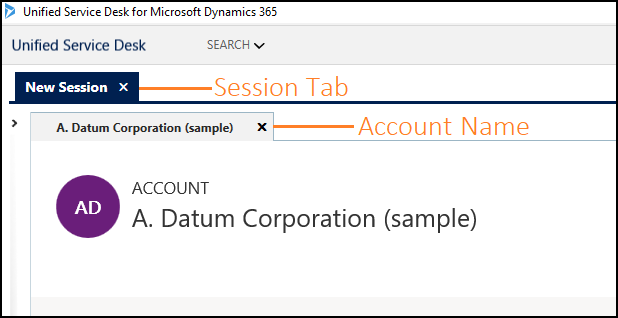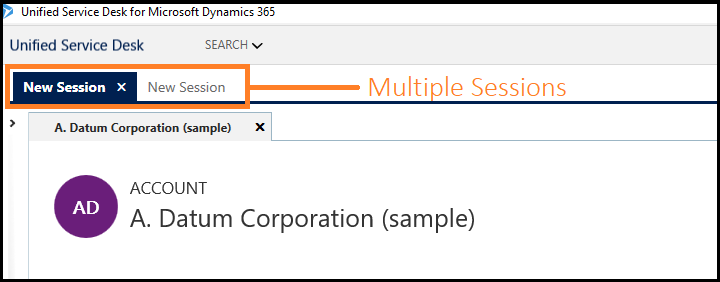Walkthrough 4: Display a Unified Interface apps record in a session in your agent application
This walkthrough demonstrates how to display records in a session in your agent application using window navigation rules and session controls in Unified Service Desk. It also demonstrates the use of replacement parameters to dynamically display the name of the hosted control based on the currently displayed account record. This walkthrough is built on top of the previous walkthrough, Walkthrough 3: Display Unified Interface apps records in your agent application, to display an account record in a session when you select one of the accounts in the Account search result window.
Prerequisites
You must have completed Walkthrough 1: Build a simple agent application for Unified Interface app and Walkthrough 3: Display Unified Interface apps records in your agent application. The configurations that you completed in these walkthroughs are required in this walkthrough.
This walkthrough assumes that you’ll be using the same user credential that you used in walkthrough 1 to sign in to the agent application at the end of the walkthrough to test the application. If a different user will be testing the application, you must assign the user to Contoso Configuration. More information: Walkthrough 1: Build a simple agent application for Unified Interface app
You must know about the following in Unified Service Desk:
Session Tabs type of hosted control. More information: Session Tabs (Hosted Control)
How to configure Action calls
How to configure window navigation rules. More information: Use window navigation rules in Unified Service Desk
Filter access using Unified Service Desk configuration. More information: Manage access using Unified Service Desk configuration
In This Walkthrough
Step 1: Create a session-scoped hosted control to display account record in a session
Step 2: Configure the event to close the hosted control from where the search originated
Step 3: Create a Session Tabs hosted control
Step 4: Create a window navigation rule to display the account record in a session
Step 5: Add the controls to the configuration
Step 1: Create a session-scoped hosted control to display account record in a session
In this step, you’ll create a session-scoped hosted control to display an account record in a session.
Sign in to Unified Service Desk Administrator
Select Hosted Controls under Basic Settings.
Select + New.
On the New Hosted Control page, specify the following values:
Field Value Name Contoso Account Session Display Name [[account.name]]
Note: We will use replacement parameter to dynamically display the name of the selected account as hosted control display name.USD Component Type Unified Interface Page Allow Multiple Pages No Pre-Fetch Data Checked Application is Global Not checked
Note: This ensures that the hosted control is session-scoped, that is, only displayed in a session.Display Group MainPanel Select Save.
Step 2: Configure the event to close the hosted control from where the search originated
In this step, you’ll configure the PageReady event on the Contoso Account Session hosted control so that when it’s loaded, the parent hosted control from where the user selected to open the account, Contoso Accounts Search, is closed. The Contoso Accounts Search hosted control was created in Walkthrough 3: Display Unified Interface apps records in your agent application. This is done to ensure that the user can’t open other account information in the same session tab.
On the Contoso Account Session hosted control, select the Related tab, and then select Events.
On the events page, select PageReady.
On the PageReady page, select Add Existing Action Call in the Active Actions area. The Lookup Records pane is displayed.
Select the search icon, and then select + New Action Call.
On the New Action Call page, specify the following values:
Field Value Name Contoso Action Call: Close Accounts Search Hosted Control Contoso Accounts Search Action Close Select Save.
Select the back button on the browser to go back to the PageReady event.
Select Add Existing Action Call. The Lookup Records pane is displayed.
Type Contoso Action Call: Close Accounts Search in the search box. Select the record from the list, and then select Add. The action call is now added to the PageReady event.
Select Save.
Step 3: Create a Session Tabs hosted control
To display records in sessions in your agent application, an instance of the Session Tabs type of hosted control must be configured in your agent application.
On the hosted control page, select + New.
On the New Hosted Control page, specify the following values:
Field Value Name Contoso Session Tab Unified Service Desk Component Type Session Tabs Update the XML in the Extensions XML field. To learn more, see Chat indicator XML.
Select Save.
Step 4: Create a window navigation rule to display the account record in a session
In this step, you’ll create a window navigation rule that displays the record in a session when the user selects any of the accounts in the search results window.
Sign in to Unified Service Desk Administrator.
Select Window Navigation Rules under Basic Settings.
Select + New.
On the New Window Navigation Rule page, specify the following values:
Field Value Name Contoso Account Session Rule Order 5 From Contoso Accounts Search Entity account Select the Result tab, and specify the following values:
Field Value Route Type In Place Destination Tab Action Create Session Target Tab Contoso Account Session Show Tab Contoso Account Session Hide Command Bar No Hide Navigation Bar Yes Select Save.
Step 5: Add the controls to the configuration
In this step, you’ll add the action call, event, hosted controls, and window navigation rule configured in this walkthrough to Contoso Configuration to display these controls to the user who is assigned to the configuration. Contoso Configuration was created in Walkthrough 1: Build a simple agent application.
Add the following to Contoso Configuration:
| Control name | Control type |
|---|---|
| Contoso Action Call: Close Accounts Search | Action call |
| PageReady | Event for the Contoso Account Session hosted control |
| Contoso Account Session | Hosted Control |
| Contoso Session Tab | Hosted Control |
| Contoso Account Session Rule | Window navigation rule |
To add a control to the configuration:
Sign in to Unified Service Desk Administrator.
Select Configuration under Advanced Settings.
Select Contoso Configuration to open the definition.
Select the Hosted Controls, Events and Action Calls tab.
Select the ellipsis (...) in the Action Calls section, and then select Add Existing Action Call. The Lookup Records pane is displayed.
Type the name of the action call mentioned in the above table in the search box. The action calls are displayed in the search results. Select the record from the list, and then select Add.
Select the ellipsis (...) in the Hosted Controls section, and then select Add Existing Hosted Control. The Lookup Records pane is displayed.
Type the name of the hosted control mentioned in the above table in the search box. The hosted controls are displayed in the search results. Select the record from the list, and then select Add.
Select the ellipsis (...) in the Events section, and then select Add Existing Events. The Lookup Records pane is displayed.
Type the name of the event mentioned in the above table in the search box. The event is displayed in the search results. Select the record from the list, and then select Add.
Select the Toolbars, Window Navigation Rules and Entity Searches tab.
Select the ellipsis (...) in the Window Navigation Rules section, and then select Add Existing Window Navigation Rule. The Lookup Records pane is displayed.
Type the name of the Window Navigation Rule mentioned in the above table in the search box. The rule is displayed in the search results. Select the record from the list, and then select Add.
Select Save.
Step 6: Test the application
Start the Unified Service Desk client application, and sign in to the Dynamics 365 instance where you configured Unified Service Desk by using the same user credentials that is assigned to Contoso Configuration in Walkthrough 1: Build a simple agent application. For information about connecting to Dataverse instance using the Unified Service Desk client application, see Connect to CRM instance using the Unified Service Desk client.
To display the account records from your model-driven app, select the down arrow next to the Search button in the toolbar, and then select Account.
Select any of the account records to display the respective account information in a session; the information is displayed under a session tab. Note that the name of the hosted control tab that contains the account record automatically displays the account name because earlier you used replacement parameters to dynamically display the current account name instead of a static value.

If you open another account record, it will be displayed in another session in your client application. To open another account, select the down arrow next to the Search button, select Account, and then select an account name to display the account information in another session.

Conclusion
In this walkthrough, you learned how to use the session hosted control and window navigation rules to display model-driven app records in a session in your agent application. You also learned how to filter access to Unified Service Desk controls using configuration.
Note
Try the next walkthrough to present enhanced session information in your agent application: Walkthrough 5: Display enhanced session information by displaying session name and overview data.
See also
Support for Unified Interface Apps in Unified Service Desk
Unified Interface Page (Hosted Control)
Unified Service Desk and Unified Interface Configuration Walkthroughs
Walkthrough 1: Build a simple agent application
Walkthrough 2: Display an external webpage in your agent application
Walkthrough 3: Display Unified Interface apps records in your agent application
Walkthrough 5: Display enhanced session information by displaying session name and overview data
Walkthrough 6: Configure the Debugger hosted control in your agent application
Walkthrough 7: Configure agent scripting in your agent application